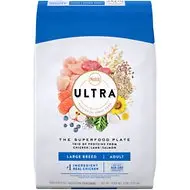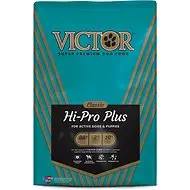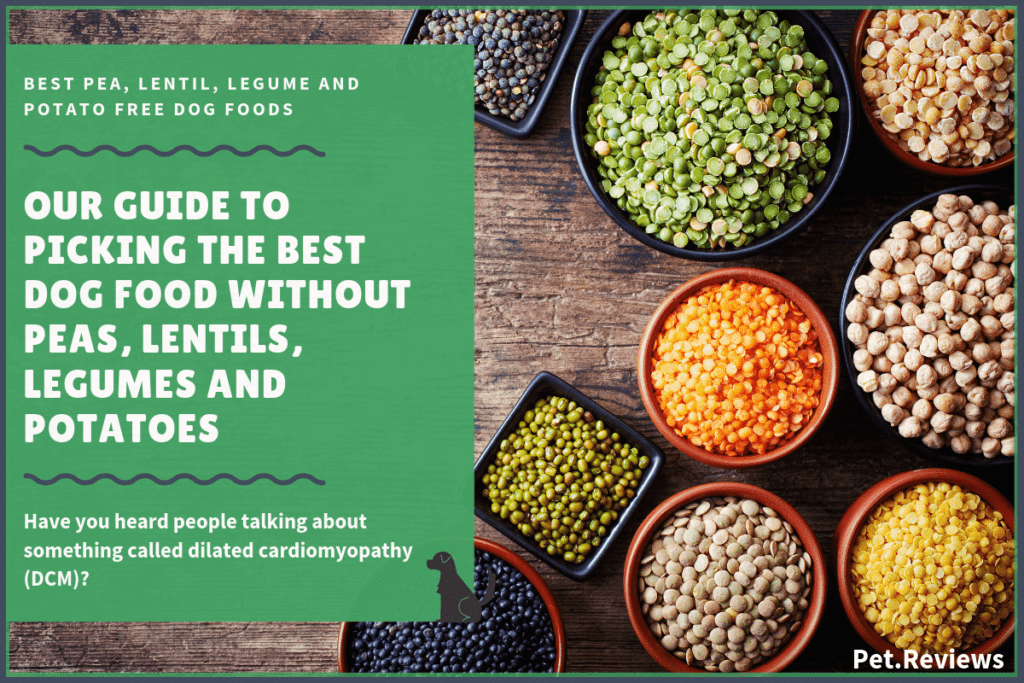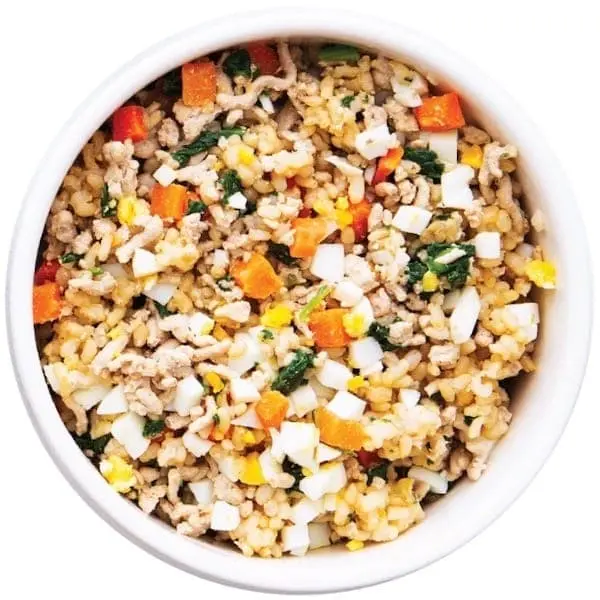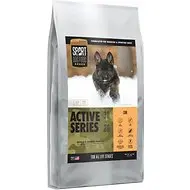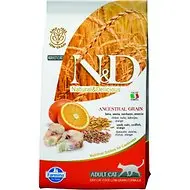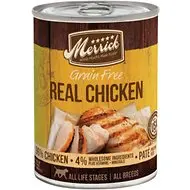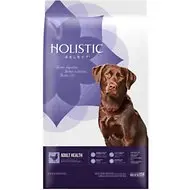10 Best Dog Foods without Peas, Legumes, Lentils & Potatoes
Quick Guide
- What is the Best Dog Food without Peas, Lentils, Legumes and Potatoes?
- The Recent Controversy Surrounding Grain-Free Diets
- Why Are Peas, Lentils, Legumes, and Potatoes Bad?
- What about boutique companies and exotic ingredients?
- What to Look for When Shopping for Dog Food
- The 10 Best Dog Foods without Peas, Lentils, Legumes, and Potatoes
- NomNomNow Human Grade Dog Food – Tasty Turkey Fare
- American Natural Premium Original Recipe
- Victor Hi-Pro Plus Formula Dry Food
- Sport Dog Food Active Series Cub Buffalo & Oatmeal Formula
- Health Extension Lite Chicken & Brown Rice Recipe Dry Food
- Farmina Natural & Delicious Wild Cod & Ancestral Low-Grain Formula Dry Food
- 4 More Top-Rated Dog Foods without Peas, Lentils, Legumes or Potatoes
- Frequently Asked Questions
All dog foods are not created equal – all it takes is a quick stroll down the dog food aisle at your local pet store to realize that. What many pet owners fail to realize, however, is that dog food formulas differ greatly in more than just price and flavor. There are significant differences in the nutritional value of one product versus another, and even in the safety of the ingredients.
Over the last year or so, mounting evidence linking grain-free diets to dilated cardiomyopathy (DCM) in dogs has sparked a panic. The FDA has issued a warning to veterinarians and pet owners about an increased risk for DCM in dogs eating pet foods made with peas, lentils, legumes, and potatoes. But what is the big deal and what could it mean for your dog?
In this article, we’ll cover the subject of peas, lentils, legumes, and potatoes in dog food as well as the nutritional implications. We’ll explore the recent FDA investigation into grain-free diets and provide you with some background information to understand the issue. Finally, we’ll show you what to look for when shopping for dog food and provide our top picks for the best dog food without peas and legumes.
What is the Best Dog Food without Peas, Lentils, Legumes and Potatoes?
- NomNomNow Human Grade Dog Food – Tasty Turkey Fare
- American Natural Premium Original Recipe – Most Popular
- Victor Hi-Pro Plus Formula Dry Food – Most Affordable
- Sport Dog Food Active Series Cub Buffalo & Oatmeal Formula
- Health Extension Lite Chicken & Brown Rice Recipe Dry Food
- Farmina Natural & Delicious Wild Cod & Ancestral Low-Grain
- Nutro Ultra Large-Breed Adult Dry Food
- Merrick Grain-Free Real Chicken Canned Dog Food
- Holistic Select Adult Health Chicken & Brown Rice Recipe
- Nature’s Logic Canine Chicken Meal Feast Dry Food
The Recent Controversy Surrounding Grain-Free Diets
You don’t have to be a pet nutrition expert to understand the basics about your dog’s nutritional requirements. While dogs are not obligate carnivores like cats, protein plays an important role in their diet and nutrition. Protein is made up of amino acids, the building blocks of strong muscle, and it is most biologically valuable when it comes from animal sources like meat, poultry, and fish. Some dog food brands use plant proteins like pea protein and potato protein to increase the total volume of protein in the recipe without using expensive animal-based ingredients.
Though protein should be the foundation of a healthy diet for dogs, many commercial dog foods are largely plant-based. It is true that dogs have the ability to digest some carbohydrates, but many dog foods are much too high in carbs. Recipes that rely on digestible sources like whole grains and starchy vegetables are usually the best option, though some dogs are sensitive or allergic to grains.
This is where grain-free dog food comes in.
Grain-free dog foods make heavy use of peas, lentils, legumes, and potatoes as alternative carbohydrate sources. Because these foods are part of a healthy diet for humans, most pet owners don’t think twice when they see them in their pet’s food. The problem is that your dog’s body can’t digest and process these foods as well as yours can, and there are certain substances in these ingredients that can be harmful for your dog in high quantities.
We’ll get more into the details about peas, lentils, legumes, and potatoes in the next section but, before we move on, here is a summary of the FDA investigation into grain-free dog foods:
- In 2025, the FDA began investigating reports linking canine dilated cardiomyopathy (DCM), a hereditary heart condition, with pet foods containing peas, lentils, legumes, and potatoes.
- In February 2025, the FDA released an update of their investigation, citing over 300 reports of DCM sent in by consumers, 90% of which were received after the initial warning was issued.
- The reports studied spanned a wide range of breeds and breed sizes – this is significant because DCM is a hereditary heart problem that most commonly affects large and giant breeds.
- A majority of cases where dogs were fed a single diet, about 90% of those reported were grain-free diets that used peas and/or lentils as one of the main ingredients.
Now that you have a better understanding of the grain-free controversy itself, you may be wondering what the real issue is. Keep reading to learn why potatoes, lentils, legumes, and peas in dog food can be such an issue.
Why Are Peas, Lentils, Legumes, and Potatoes Bad?
Peas, lentils, and legumes are generally considered healthy for humans, so why are they bad for dogs? Though these ingredients contain carbohydrate energy, fiber, and essential nutrients, they also contain substances that can be harmful for your dog. Phytoestrogens, for example, may contribute to fertility problems and lectins, phytates, and oxalates can affect your dog’s digestion and reduce his ability to absorb and utilize key nutrients like zinc, calcium, and iron.
As you already know, these foods have also been linked to an increased risk for DCM.
Dilated cardiomyopathy is a form of heart disease in which the heart becomes enlarged. As the heart gets larger, it struggles to beat as well as it should, which impacts your dog’s circulation, both to and from the heart. Over time, DCM can lead to symptoms such as lethargy, coughing, decreased appetite, pale gums, and fainting. If left untreated, DCM can be fatal.
Here is a quick list of some of the ingredients the FDA has linked to DCM:
- Peas (including pea fiber, peas, and pea protein)
- Lentils (all varieties)
- Other legumes (like chickpeas, beans, and soybeans)
- Potatoes and sweet potatoes
- Pulses (edible legume seeds)
What about boutique companies and exotic ingredients?
If you read the FDA report about rising concerns for DCM in dogs, you may have noticed that peas, lentils, legumes, and potatoes are not the only ingredients implicated. Some veterinary experts like Lisa Freeman suggest that it is not just grain-free diets that are the problem – it is a whole category of pet foods she labels BEG diets. This category includes products made by boutique companies, foods featuring exotic ingredients, and grain-free diets.
The issue with BEG diets is that products made by boutique companies may not be formulated by a qualified veterinary nutritionist. The exotic ingredients used in these and other recipes can also be challenging to formulate correctly. The lesson here is that, unless your dog has severe allergies and there are no other options, you may want to avoid boutique and exotic pet foods.
What to Look for When Shopping for Dog Food
The lesson to take away is that unless your dog really needs a grain-free diet, it may be best to avoid grain-free dog food. Dogs that are not allergic or sensitive to grains can actually benefit from the inclusion of whole grains in their diet – there is nothing inherently healthier about a grain-free diet versus a regular dog food. You should always keep your dog’s unique nutritional needs and dietary preferences in mind, but it is your responsibility to choose a safe and healthy diet for your dog.
Here are some general things to look for when shopping for a dog food without peas and legumes:
- Real animal protein as the first ingredient. Adult dogs require a minimum of 18% protein in their diet, and puppies need at least 22%. Animal proteins like meat, poultry, and fish are the most biologically valuable for your dog, so make sure an animal ingredient comes first.
- Rich blend of omega-3 and omega-6 fatty acids. Essential fats provide your dog with a concentrated source of energy as well as support for his skin and coat. Look for animal fats like chicken fat and salmon oil with plant oils to balance the omega-3 and omega-6 content.
- Highly digestible carbohydrates. Most dogs can digest whole-grains, so look for a recipe that contains nutritious options like whole-grain brown rice, oatmeal, or pearled barley. If your dog can’t digest grains, look for alternatives like tapioca and starchy veggies, not legumes or peas.
- Fortified with beneficial supplements. All dogs need a balance of certain vitamins and minerals in their diet, so most commercial foods contain synthetic supplements. Just know that chelated minerals are the best because they are bound to protein molecules to increase absorption.
- Complete and balanced nutrition. Check the package for an AAFCO statement of nutritional adequacy to be sure the product is formulated to meet your dog’s minimum nutritional requirements. Just remember that this statement doesn’t guarantee quality – you still need to read the ingredients list to make sure the product you’re buying is a good one.
As you can see, these five things can be applied to a wide variety of different products. As long as your dog’s nutritional needs are being met, you have the freedom to choose from a wide variety of dog foods. If you’re not sure where to look for the best legume-free dog food, simply consider one of the 10 options we’ve reviewed below.
The 10 Best Dog Foods without Peas, Lentils, Legumes, and Potatoes
The FDA has not issued an official statement advising pet owners to avoid grain-free dog foods, but the results of their investigation that have been released thus far should make you think twice. It is important to choose a dog food made with premium sources of animal protein and healthy fats – carbohydrates are less important, but they should still come from digestible sources.
When shopping for the best legume-free dog food, consider some of our favorites if you’re not sure where to start. Here’s our top pick for the best dog food without phytoestrogens:
| Our 2025 Picks: Best Dog Food without Peas, Lentils, Legumes and Potatoes | |||
NomNomNow Human Grade Dog Food – Tasty Turkey Fare
|
CHECK PRICE | ||
American Natural Premium Original Recipe
|
CHECK PRICE | ||
Victor Hi-Pro Plus Formula Dry Food
|
CHECK PRICE | ||
Sport Dog Food Active Series Cub Buffalo & Oatmeal Formula
|
CHECK PRICE | ||
Health Extension Lite Chicken & Brown Rice Recipe Dry Food
|
CHECK PRICE | ||
Farmina Natural & Delicious Wild Cod & Ancestral Low-Grain
|
CHECK PRICE | ||
Nutro Ultra Large-Breed Adult Dry Food
|
CHECK PRICE | ||
Merrick Grain-Free Real Chicken Canned Dog Food
|
CHECK PRICE | ||
Holistic Select Adult Health Chicken & Brown Rice
|
CHECK PRICE | ||
Nature’s Logic Canine Chicken Meal Feast Dry Food
|
CHECK PRICE | ||
NomNomNow Human Grade Dog Food – Tasty Turkey Fare
Overall Best Dog Food without Peas and Legumes: If you want what’s best for your dog, choose a dog food made with wholesome, natural ingredients in a complete and balanced formula. Many pet experts agree that fresh food is the best product to provide for these needs, and NomNomNow is one of the top brands currently offering it. Simply provide some basic information about your dog’s age, breed, and weight, then NomNomNow will send you monthly shipments of freshly prepared dog food pre-portioned according to your dog’s calorie needs. Simply open one bag each day and divide it into as many meals as you like. All of their recipes start with a premium source of animal protein with highly digestible whole foods like carrots, spinach, squash, and whole grains. Keep in mind that some recipes contain potatoes or sweet potatoes but the Tasty Turkey Fare is made with whole-grain brown rice and fresh vegetables – no peas, legumes, potatoes, or lentils.
- Pros: Fresh food delivered to your door, prepared in small batches to ensure nutritional quality, whole-food ingredients, pre-portioned packages according to your dog’s calorie needs
- Cons: Fairly expensive to feed as a staple diet, limited number of recipe options
American Natural Premium Original Recipe
Most Popular Dog Food without Peas and Legumes: Because there are so many different dog foods out there, it can be difficult to make the right choice. If you’re not sure where to go for a dog food without peas and legumes, try a popular choice like this American Natural Premium Original Recipe. This formula is entirely free from peas, legumes, lentils, and potatoes, made instead with highly digestible whole grains like oatmeal and brown rice. It is cooked in small batches to ensure the nutritional integrity of each bag and is supplemented as needed for complete and balanced nutrition. This formula features chicken meal as a concentrated source of lean protein with supplemental proteins like pork meal and fish meal. It is rich in omega fatty acids for healthy skin and coat, plus it contains beneficial supplements like chelated minerals and probiotics.
- Pros: Concentrated source of lean protein, digestible whole grains, rich in omega fatty acids for skin and coat, no legumes or potatoes, dried fermentation products for digestion, chelated minerals
- Cons: Contains some unnamed ingredients (fish meal vs. salmon meal)
Victor Hi-Pro Plus Formula Dry Food
Most Affordable Dog Food without Peas and Legumes: You’ve probably heard the saying that good dog food isn’t cheap and cheap dog food isn’t good. Well, it’s true! This doesn’t mean, however, that you can’t find a decent quality dog food at an affordable price. If you’re looking for a good dog food without legumes or potatoes that won’t break the bank, try this Victor Hi-Pro Plus Formula Dry Food. Priced around $1.20/pound, it is much more affordable than many dog foods on the market but still offers decent nutritional quality. It contains 88% meat protein from beef, chicken, and pork with whole-grain carbohydrates like sorghum and millet. This formula provides a total of 30% protein and 20% fat with just over 400 calories per cup, making it a nutrient-dense option for dogs of all breeds and ages. Plus, it is supplemented with chelated minerals for optimal nutrient absorption and dried fermentation products for probiotic support.
- Pros: Made with 88% animal protein, digestible whole-grain carbohydrates, rich blend of omega fatty acids for skin and coat support, chelated mineral supplements, probiotics for digestion
- Cons: Some dogs may be sensitive to common proteins like chicken, beef, and pork
Sport Dog Food Active Series Cub Buffalo & Oatmeal Formula
Best Pea-Free Dog Food for Puppies: If you want your puppy to grow up well, start by feeding him a pea, lentil, and potato-free dog food. Sport Dog Food is a high-quality brand that excludes peas, lentils, potatoes, and legumes from all of their recipes. This company believes that dogs deserve the highest quality nutrition and that it comes from premium sources of animal protein and digestible carbohydrates. This particular recipe features buffalo meal as a concentrated source of protein and the first ingredient, followed by oatmeal as the main carbohydrate. It also contains supplemental proteins like pork meal and catfish meal with a rich blend of omega fatty acids from salmon oil and pumpkin meal. Overall, this recipe provides 30% protein and 20% fat at 526 calories per cup, making it a great option for growing puppies.
- Pros: Completely free from peas and legumes, rich in protein and fat (30% and 20%), buffalo meal as first ingredient, rich in omega fatty acids, dried fermentation products for digestion, chelated minerals
- Cons: Does contain some sweet potato, fairly expensive compared to other brands
Health Extension Lite Chicken & Brown Rice Recipe Dry Food
Best Pea-Free Dog Food for Seniors: As your dog starts to get older, his metabolism may slow down, and his risk for obesity increases. If you’re looking for the best legume-free dog food for an older dog, we recommend this Health Extension Lite Chicken & Brown Rice Recipe Dry Food. This formula features fresh chicken as the primary ingredient, a lean source of protein, supplemented by chicken meal as a concentrated source of lean protein. This recipe contains whole-grain carbohydrates like brown rice and oatmeal with supplemental fiber from flaxseed and dried beet pulp. It contains a rich blend of omega fatty acids for skin and coat support with bone- and joint-supporting nutrients like glucosamine and chondroitin. This formula is rich in protein at 24% with just 9% fat and 288 calories per cup, making it a great option if your dog needs to lose weight or if you’re concerned about him gaining weight. This recipe is fortified with essential vitamins and minerals as well as dried fermentation products for probiotic support.
- Pros: Fresh chicken as main ingredient, digestible whole-grain carbohydrates, rich blend of omega fatty acids, supplemental fiber for healthy digestion, probiotics, glucosamine and chondroitin for joints
- Cons: Some dogs may be sensitive to chicken ingredients
Farmina Natural & Delicious Wild Cod & Ancestral Low-Grain Formula Dry Food
Best Pea Free Dog Food for Sensitive Stomach: If your dog has a sensitive stomach or food allergies, you need to be careful what you feed him. Look for a recipe made with a limited number of high-quality, digestible ingredients that is free from whatever is triggering your dog’s allergy. This Farmina Natural & Delicious Wild Cod & Ancestral Low-Grain Formula is a great option because it contains fresh, wild-caught cod as the main ingredient and a novel source of animal protein. It also contains digestible whole grains like spelt and oats with nutritional support from dried fruits and vegetables. This recipe features a high protein content (30%) with moderate fat and calories, making it a great option for dogs in all life stages. It is supplemented with fiber for healthy digestion with chelated minerals to ensure optimal nutrient absorption. Overall, this recipe contains 92% protein from premium animal sources, and it is a low-carb, low-glycemic recipe which helps improve its digestibility while also keeping your dog’s blood sugar stable.
- Pros: Low-glycemic formula, wild cod as main ingredient, digestible whole grains, dried fruits and vegetables, chelated minerals for optimal nutrient absorption, rich in omega fatty acids
- Cons: Very expensive to feed as a staple diet, not a single-source protein recipe
4 More Top-Rated Dog Foods without Peas, Lentils, Legumes or Potatoes
Having cultivated an understanding of the potential dangers of grain-free dog food, you have the knowledge you need to make a smart choice for your dog. If none of the recipes reviewed above seem like the perfect fit, don’t worry – you still have plenty of other options!
Here are four more recipes we recommend for dog food without legumes or potatoes:
Nutro Ultra Large-Breed Adult Dry Food
Large-breed dogs have slightly different nutritional needs than smaller dogs. They still require a diet rich in protein and healthy fats, but they need to have their calorie intake controlled to prevent them from growing too fast and to reduce their risk of bone and joint problems. This Nutro Ultra Large-Breed Adult Dry Food is a great option because it is uniquely formulated for large breeds, made with a lean source of premium animal protein and natural sources of joint-supporting glucosamine and chondroitin. This formula also contains several supplemental forms of protein, including salmon meal and lamb meal with plenty of omega fatty acids for healthy skin and coat. It contains supplemental fiber for healthy digestion with vitamins and chelated mineral supplements to ensure complete and balanced nutrition. Overall, it provides 23% protein and 12% fat with 346 calories per cup.
- Pros: Formulated for large breeds, lean source of protein, highly digestible whole-grain carbohydrates, dried fruits and vegetables, chelated mineral supplements, rich in omega fatty acids
- Cons: Could be higher in protein, fairly expensive to feed as a staple diet
Merrick Grain-Free Real Chicken Canned Dog Food
If you’re concerned about legumes, peas, and lentils in your dog’s food, you might want to consider a canned food diet. Canned food tends to be lower in carbohydrate content than dry food in general, so it may be easier to find a wet food recipe that doesn’t contain peas, lentils, legumes, or potatoes. We recommend this Merrick Grain-Free Real Chicken Canned Dog Food because it is protein-rich, highly digestible, and doesn’t contain any of those potentially harmful ingredients. The thing to keep in mind here is that, while the recipe is labeled grain-free, it does not contain peas, legumes, lentils, or potatoes. In fact, it doesn’t contain any carbohydrate ingredients other than flaxseed and some natural gums for thickening. This formula features salmon oil as a rich source of omega fatty acids to support your dog’s healthy skin and coat with vitamin and chelated mineral supplements to ensure complete and balanced nutrition. Overall, it provides 10% protein and 7% fat by volume with 1,030 kcal/kg.
- Pros: Fresh chicken as main ingredient, very low in carbohydrates, rich in omega fatty acids for skin and coat, chelated minerals for optimal nutrient absorption, complete and balanced
- Cons: Grain-free label may be confusing
Holistic Select Adult Health Chicken & Brown Rice Recipe Dry Food
The quality of your dog’s food has a direct impact on his health and wellness, which is why we like this holistic, natural recipe. This Holistic Select Adult Health Chicken & Brown Rice Recipe Dry Food features chicken meal as a concentrated source of lean protein with supplemental protein from pork meal. It contains digestible whole-grain carbohydrates like brown rice and oatmeal with supplemental fiber from several sources to support your dog’s healthy and regular digestion. It features salmon oil and flaxseed as rich sources of omega-3 and omega-6 fatty acids for healthy skin and coat, providing a total of 15% fat. This recipe is supplemented with vitamins and chelated minerals to ensure complete and balanced nutrition with dried fermentation products for probiotic support.
- Pros: Holistic natural recipe, chicken meal as main ingredient, digestible whole-grain carbohydrates, formulated for healthy digestion, antioxidant-rich superfoods, fresh fruits and veggies
- Cons: Some dogs may be sensitive to pork ingredients
Nature’s Logic Canine Chicken Meal Feast Dry Food
The quality of the ingredients in your dog’s food determines the quality of his nutrition. This Nature’s Logic Canine Chicken Meal Feast Dry Food is a great choice if you’re looking for the best legume-free dog food because it doesn’t contain any peas, lentils, legumes, or potatoes but does contain a variety of dried fruits and vegetables to provide rich sources of key nutrients. This recipe features chicken meal as the main ingredient and a lean source of premium animal protein. It contains several whole grains as well as seeds to provide carbohydrate energy, fiber, and essential nutrients. This recipe provides a full 36% protein and 15% fat with 418 calories per cup. Simply put, it is a rich source of healthy and balanced nutrition for your dog while still being free from peas, legumes, lentils, and potatoes.
- Pros: Concentrate source of lean animal protein, digestible whole-grain carbohydrates, dried fruits and vegetables, rich in omega fatty acids, dried fermentation products for probiotic support
- Cons: Very expensive to feed as a staple diet
Frequently Asked Questions
- Are peas bad in dog food? – Peas are not an unhealthy ingredient – at least, not for humans. For dogs, they can provide calories, fiber, and supplemental protein, but they are less biologically valuable than an animal-based ingredient. The main problem with peas is that many dog food companies use them to increase the protein content of the recipe without adding more meat. They also contain phytoestrogens and lectins, which can contribute to health problems in dogs.
- Why is grain-free food bad for dogs? – Grain-free dog food is not necessarily bad, but a recent FDA investigation suggests that pet owners should be wary of feeding their dogs grain-free food. The primary concern with grain-free diets right now is the link with dilated cardiomyopathy or DCM. This is a heart condition most commonly seen in large and giant breeds, but the FDA has discovered over 300 cases linking grain-free diets to DCM in dogs that would not normally be at-risk for the disease. There is not enough evidence yet to say whether it is truly the grain-free diet to blame, but there is a strong enough link to make you think twice.
- Are Peas Legumes? – Yes, peas are legumes. The legume family is very large. It includes peas, lentils, beans, lupins, soybeans, and peanuts, to name just a few. Legumes can be good sources of protein, dietary fiber, carbohydrates, and dietary minerals. However, not all animals are able to digest various legumes well. There has been a lot of research about farm animals and legumes but not much about dogs and legumes.
- Is Pea Protein Bad for Dogs? – A small amount of pea protein is not bad for your dog. However, if you read the ingredient lists on some dog foods you will discover that pea protein (and pea fiber and pea starch) are often listed quite high on the list. Pea protein is a plant protein and dogs don’t digest plant protein as well as meat protein. Pet food manufacturers add ingredients like pea protein to dog food to boost the protein percentage. This allows them to reduce the amount of meat/animal protein in the food which is more expensive for them to buy. Pea protein costs a lot less than meat protein. This is being done in some very expensive dog foods. The protein percentages continue to look high but the meat/animal percentage in the food has fallen. Dogs cannot thrive on this kind of diet.
- Are all Grain-Free Diets Bad? – No, not all grain free diets are bad. The FDA has not advised people to stop feeding grain free diets. The agency advised people to stop feeding foods that contained peas, lentils, legumes, and potatoes in the first 10 ingredients. However some researchers and veterinary cardiologists have recommended that dog lovers switch to diets that include grains. There are some grain free diets that don’t include peas, lentils, legumes, or potatoes. They can be hard to find but we have tried to find a few for you in our list.
- Is the FDA Going to Release More Information? – The FDA’s last update was released in February 2025. At that time the agency said that their veterinarians were still collecting information from the public, collaborating with veterinary cardiologists and researchers, and analyzing data. They said that they were continuing to investigate and would provide information to the public as things developed. So far there has not been a solution found or even a definitive cause of the dietary DCM in dogs.
Now that you have a better understanding of peas, legumes, and potatoes in pet food, you can make a smart decision about whether to include these foods in your dog’s diet. If you decide that a pea-free and potato-free dog food is the way to go, you have the information you need to find one.
When in doubt, you can always choose one of the dog foods we recommend. Simply check out the list above to see our top picks for the best dog food without phytoestrogens.


